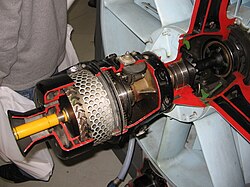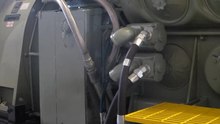Air-start system
This article needs additional citations for verification. (April 2013) |

An air-start system is a power source used to provide the initial rotation to start large diesel and gas turbine engines.
Diesel engines[]
Direct starting[]
Compared to a gasoline (petrol) engine, a Diesel engine has a very high compression ratio, an essential design feature, as it is the heat of compression that ignites the fuel. An electric starter with sufficient power to "crank" a large Diesel engine would itself be so large as to be impractical, thus the need for an alternative system.
When starting the engine, compressed air is admitted to whichever cylinder has a piston just over top dead center, forcing it downward.[1] As the engine starts to turn, the air-start valve on the next cylinder in line opens to continue the rotation. After several rotations, fuel is injected into the cylinders, the engine starts running and the air is cut off.
To further complicate matters, a large engine is usually "blown over" first with zero fuel settings and the indicator cocks open, to prove that the engine is clear of any water build up and that everything is free to turn. After a successful blow ahead and a blow astern, the indicator cocks are closed on all the cylinders, and then the engine can be started on fuel. Significant complexity is added to the engine by using an air-start system, as the cylinder head must have an extra valve in each cylinder to admit the air in for starting, plus the required control systems. This added complexity and cost limits the use of air-starters to very large and expensive reciprocating engines.
Starter motor[]
Another method of air-starting an internal combustion engine is by using compressed air or gas to drive a fluid motor in place of an electric motor.[2] They can be used to start engines from 5 to 320 liters in size and if more starting power is necessary two or more motors can be used. Starters of this type are used in place of electric motors because of their lighter weight and higher reliability. They can also outlast an electric starter by a factor of three and are easier to rebuild. Engines operating in underground mining activities tend to operate on this type of starter system to reduce the risk of an electrical system igniting flammable material.
All vane type air starters should have a lubricator installed to insure long-life and maximum performance.[3] Lubricators give the moving parts a needed friction barrier, reduce metal corrosion and keep vanes sealed properly against the cylinder walls. Even the so-called lube-free air starters require lubrication to prolong trouble free life. Two basic lubricator devices are typically employed. One is an in-line or reservoir type that typically stores up to 2 quarts of lubricant, and is installed along the air supply line. The second style of lubricator is a small one shot device that dispenses a measured amount of lubricant every time the starter is engaged. Installed directly onto the air inlet of the starter, the in-line lubricators are self priming pneumatic pumps that require a 1/4″ lubrication line piped from as far away as 4 feet. Air Starter lubricators perform best using misting type, non-detergent oils such as diesel fuel or Marvel Mystery oil. If emissions are a concern, there are environmentally friendly type lubricants available on the market.
Not all air starters require lubrication. Turbine type air starters do not require air motor lubrication, although some turbine air starters do use an oil filled transmission that may require periodic inspections and maintenance.
Gas turbines[]
An air-starter or huffer on a turbine engine would typically consist of a radial inward flow turbine, or axial flow turbine, which is connected to the high pressure compressor spool through the accessory gearbox, plus the associated piping and valves. Compressed air is provided to the system by bleed air from the aircraft's auxiliary power unit or from an air compressor mounted on ground support equipment.
Advantages[]
Compared with electric starters, air-starters have a higher power-to-weight ratio. Electric starters and their wiring can become excessively hot if it takes longer than expected to start the engine, while air-starters can run as long as their air supply lasts. Air-starters are much simpler and are compatible with turbine engines, and thus are used on many designs of large turbofan engine that are installed on commercial and military aircraft.
See also[]
- Air Start Unit
- AVPIN - A monofuel used to power turbojet starter motors.
- Coffman engine starter - A similar system which uses an explosive cartridge to supply gas pressure.
References[]
- ^ "The air start system at marinediesels.co.uk How a marine diesel engine starts using compressed air". Marinediesels.info. Retrieved 2013-04-15.
- ^ "IPU Group - Jetstream 4 & 5 pre-engaged Air Starter Motors". Ipu.co.uk. Retrieved 2013-04-16.
- ^ "Frequently asked questions". Air Starter Components.
- Starting systems
